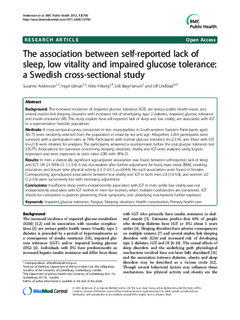| dc.contributor.author | Andersson, Susanne | |
| dc.contributor.author | Ekman, Inger | |
| dc.contributor.author | Friberg, Febe | |
| dc.contributor.author | Bøg-Hansen, Erik | |
| dc.contributor.author | Lindblad, Ulf | |
| dc.coverage.spatial | Sweden | nb_NO |
| dc.date.accessioned | 2017-02-13T09:41:45Z | |
| dc.date.available | 2017-02-13T09:41:45Z | |
| dc.date.issued | 2013-07 | |
| dc.identifier.uri | http://hdl.handle.net/11250/2430385 | |
| dc.description | © 2013 Andersson et al.; licensee BioMed Central Ltd. This is an Open Access article originally published in BMC Public Health, distributed under the terms of the Creative Commons Attribution License (http://creativecommons.org/licenses/by/2.0), which permits unrestricted use, distribution, and reproduction in any medium, provided the original work is properly cited. | nb_NO |
| dc.description.abstract | Background: The increased incidence of impaired glucose tolerance (IGT), are serious public health issues, and several studies link sleeping disorders with increased risk of developing type 2 diabetes, impaired glucose tolerance and insulin resistance (IR). This study explore how self-reported lack of sleep and low vitality, are associated with IGT in a representative Swedish population.
Methods: A cross-sectional survey conducted in two municipalities in South-western Sweden. Participants aged 30–75 were randomly selected from the population in strata by sex and age. Altogether, 2,816 participants were surveyed with a participation rates at 76%. Participants with normal glucose tolerance (n=2,314), and those with IGT (n=213) were retained for analyses. The participants answered a questionnaire before the oral glucose tolerance test (OGTT). Associations for questions concerning sleeping disorders, vitality and IGT were analysed using logistic regression and were expressed as odds ratios (OR) with 95% CI.
Results: In men a statistically significant age-adjusted association was found between self-reported lack of sleep and IGT: OR 2.4 (95% CI: 1.1-5.4). It did not weaken after further adjustment for body mass index (BMI), smoking, education, and leisure time physical activity 2.3 (1.0-5.5, p=0.044). No such associations were found in females.
Corresponding age-adjusted associations between low vitality and IGT in both men 2.8 (1.3-5.8), and women 2.0 (1.2-3.4) were successively lost with increasing adjustment.
Conclusions: Insufficient sleep seems independently associated with IGT in men, while low vitality was not independently associated with IGT neither in men nor women, when multiple confounders are considered. IGT should be considered in patients presenting these symptoms, and underlying mechanisms further explored. | nb_NO |
| dc.language.iso | eng | nb_NO |
| dc.publisher | BioMed Central | nb_NO |
| dc.rights | Navngivelse 4.0 Internasjonal | * |
| dc.rights.uri | http://creativecommons.org/licenses/by/4.0/deed.no | * |
| dc.subject | impaired glucose tolerance | nb_NO |
| dc.subject | fatigue | nb_NO |
| dc.subject | sleep disorders | nb_NO |
| dc.subject | health conversation | nb_NO |
| dc.subject | primary health care | nb_NO |
| dc.subject | helse- og sosialfag | nb_NO |
| dc.subject | søvnvansker | nb_NO |
| dc.subject | søvnproblemer | nb_NO |
| dc.title | The association between self-reported lack of sleep, low vitality and impaired glucose tolerance: a Swedish cross-sectional study | nb_NO |
| dc.type | Journal article | nb_NO |
| dc.type | Peer reviewed | nb_NO |
| dc.subject.nsi | VDP::Medisinske Fag: 700::Helsefag: 800 | nb_NO |
| dc.source.volume | 13 | nb_NO |
| dc.source.journal | BMC Public Health | nb_NO |
| dc.source.issue | 700 | nb_NO |
| dc.identifier.doi | 10.1186/1471-2458-13-700 | |

